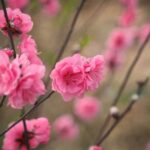Design a flower garden layout to transform your outdoor space into a vibrant and colorful oasis. Whether you have a small backyard or a spacious open area, creating a well-thought-out flower garden layout can bring life and beauty to your surroundings. From understanding your space and selecting the right flowers to planning a color scheme and incorporating additional features, designing a flower garden layout is an exciting and rewarding endeavor.
When done correctly, a thoughtfully designed flower garden can enhance the aesthetic appeal of your outdoor space, creating an inviting and tranquil atmosphere for relaxation and enjoyment. By carefully considering factors such as sunlight, soil quality, and space available, you can create an environment that not only looks stunning but also thrives all year round.
In this article, we will explore the various aspects of designing a flower garden layout, from assessing your space and selecting the right flowers to sketching out your design and incorporating seasonal care tips. Whether you are new to gardening or have years of experience, this guide will provide valuable insights and practical advice for bringing your flower garden layout to life.
Get ready to embark on an exciting journey of creativity, beauty, and nature as we delve into the world of designing a flower garden layout.
Understanding Your Space
When it comes to designing a beautiful flower garden, one of the most important steps is understanding your space. Assessing the area and sunlight for your flower garden will ensure that you choose the right plants and create a layout that thrives in your specific outdoor environment.
Assessing the Area
Before you start planning your flower garden layout, take some time to assess the area where you want to plant. Consider factors such as the size and shape of the space, existing landscaping features, and any potential obstacles or challenges. Understanding the physical aspects of your outdoor space will help you plan a layout that makes the most of what you have to work with.
Evaluating Sunlight
Another crucial aspect of understanding your space is evaluating sunlight exposure. Different flowers have varying light requirements, so it’s essential to determine how much sunlight each area of your garden receives throughout the day. Take note of areas that get full sun, partial shade, or full shade, as this will influence which plants will thrive in each location.
By taking the time to thoroughly assess your space and its sunlight conditions, you’ll be better equipped to design a flower garden layout that not only looks beautiful but also flourishes in its environment. With this knowledge in hand, you can move forward with researching and selecting the best flower varieties for your unique outdoor space.
Choosing the Right Flowers
When it comes to designing a flower garden layout, one of the key elements to consider is the selection of the right flowers. Researching and selecting the best varieties for your garden can make a significant impact on the overall look and feel of your outdoor space.
Before choosing which flowers to plant, it’s important to take into account factors such as climate, soil type, and sunlight exposure. By taking the time to carefully select your flowers, you can ensure that your garden will thrive and flourish.
When researching different flower varieties, consider not only their aesthetic appeal but also their practicality. Some flowers may be more suitable for your specific region or climate, while others may require more maintenance than you are willing to commit to. Additionally, think about the overall design and color scheme of your garden when choosing flowers. You may want to opt for a mix of vibrant hues or a more monochromatic scheme depending on your preferences.
Before making any final decisions, it’s a good idea to visit local nurseries or botanical gardens to get inspiration and advice from experts. They can provide valuable insight into which flower varieties are best suited for your area and offer guidance on how to care for them properly. Once you have chosen the right flowers for your garden, you can move on to the next step in designing your flower garden layout.
| Flower Variety | Climate Suitability |
|---|---|
| Roses | Wide range of climates |
| Tulips | Cooler climates |
| Lavender | Warm and dry climates |
Creating a Color Scheme
Choosing the right color scheme for your flower garden is essential in creating a beautiful and harmonious outdoor space. Consider the colors you are naturally drawn to and think about how they will complement each other when planted together. A good starting point is to pick a dominant color, such as purple or yellow, and then choose flowers that complement or contrast with it.
When planning your color scheme, take into account the seasonality of your chosen flowers. You’ll want to ensure that you have blooms throughout the year, so consider mixing annuals with perennials to achieve continuous color.
Additionally, think about how the colors will work with your overall garden aesthetic. For example, if you have a cottage garden style, you may want to go for a mix of pastel shades, while a more modern garden could benefit from a monochromatic color scheme.
A well-designed color scheme can elevate the visual impact of your flower garden. By strategically combining different hues and tones, you can create a truly stunning display that will be the envy of your neighbors. Don’t be afraid to experiment and try new combinations – that’s all part of the fun in designing your flower garden.
| Color Type | Recommended Flowers |
|---|---|
| Monochromatic | Lavender, Violet, White Iris |
| Analogous | Rose Pink, Peach, Coral Snapdragons |
| Complementary | Yellow Marigold, Purple Petunia |
Sketching Your Design
When it comes to creating a beautifully designed flower garden, sketching out your design can be a crucial step in the planning process. By mapping out your flower garden layout, you can visualize the placement of different flowers and elements, ensuring a cohesive and aesthetically pleasing result. Below are some tips and tricks for sketching out your flower garden design:
Consider the Layout
Before you begin sketching, take some time to consider the overall layout of your outdoor space. Think about the size and shape of the area where you want to create your flower garden, as well as any existing features such as trees, shrubs, or pathways. Understanding the layout will help you make informed decisions about where to place different elements in your garden.
Plan for Growth
When sketching out your flower garden layout, it’s important to consider the potential growth of the plants you choose. Take into account their mature size and spread, as well as their growth habits. This will help you avoid overcrowding and ensure that each plant has enough space to thrive.
Use Graph Paper
One helpful tip for mapping out your flower garden design is to use graph paper for your sketches. The grid lines on graph paper can help you accurately measure and scale your drawings, allowing for precise placement of flowers and other elements in your garden.
By taking the time to carefully sketch out your flower garden design, you’ll have a clear roadmap for creating a beautiful and functional outdoor space that you can enjoy for years to come.
Planting and Maintenance
Designing a flower garden layout is just the first step, now it’s time to get your hands dirty and bring your vision to life. Planting and maintenance are crucial for the success of your flower garden, so here is a step-by-step guide on how to plant and care for your beautiful blooms.
First, prepare the soil by removing any weeds, rocks, or debris from the area. Loosen the soil and add organic matter such as compost to improve its texture and fertility. Next, consider the right planting technique for each type of flower you have chosen. Some may need to be spaced a certain distance apart, while others may require specific depths for planting. Be sure to follow the instructions provided with each plant or seed packet.
Once your flowers are in the ground, it’s important to establish a routine watering schedule. Most flowers require regular watering, especially during hot and dry spells. Be mindful not to overwater as this can lead to root rot, but also ensure that the soil doesn’t dry out completely between waterings. In addition to watering, make sure to regularly weed your flower garden to prevent unwanted plants from competing with your beautiful blooms for water and nutrients.
Finally, regular maintenance is essential for keeping your flower garden healthy and vibrant. This includes deadheading spent flowers to encourage new growth, fertilizing as needed according to plant requirements, and monitoring for any signs of pests or disease. By following these steps and providing proper care, you can enjoy a thriving and beautiful flower garden all season long.
Remember that every flower species has different needs in terms of sunlight exposure preferences; doing some research is necessary if we want our flowers not only survive but thrive attracting an abundant flora & fauna ecosystem in our backyard.
Adding Accents
When it comes to designing a flower garden layout, adding accents can truly elevate the overall look and feel of your outdoor space. By incorporating features such as pathways, fountains, and garden ornaments, you can create a more visually appealing and inviting garden. Here are some tips for adding accents to your flower garden layout:
- Pathways: Consider adding winding pathways that meander through your garden, creating a sense of intrigue and discovery. You can use materials like gravel, stepping stones, or brick to define the pathways and create visual interest.
- Fountains: Adding a fountain to your flower garden can bring a sense of tranquility and relaxation. Whether you opt for a small tabletop fountain or a larger standalone feature, the sound of flowing water can enhance the ambiance of your garden.
- Garden Ornaments: From statues and birdbaths to decorative lanterns and wind chimes, there are countless options for incorporating garden ornaments into your layout. Choose pieces that complement the style of your garden and add personality to the space.
Incorporating these accents into your flower garden layout not only adds visual appeal but also creates an opportunity to engage visitors on a sensory level. A well-designed pathway can encourage exploration and discovery, while the sight and sound of a fountain can evoke feelings of peace and serenity. Garden ornaments can also serve as focal points or conversation starters, adding character to your outdoor space.
Ultimately, the key is to strike a balance between the beauty of your flowers and the complementary features you choose to include in your layout. By integrating pathways, fountains, and garden ornaments thoughtfully, you can transform your flower garden into a captivating oasis that is sure to delight both guests and occupants alike.
Seasonal Care
Once you have designed and planted your flower garden, it is important to consider the seasonal care it will require to keep it looking beautiful year-round. Taking care of your garden throughout the different seasons will ensure that your flowers thrive and continue to bring color and vibrancy to your outdoor space. Here are some essential tips for seasonal care:
- Spring: In the spring, it is important to clean up your garden by removing any dead foliage or debris left over from winter. Trim back any perennials or shrubs that may have become overgrown, and provide support for taller plants if needed.
- Summer: During the summer months, make sure to water your garden regularly, especially in times of high heat. Deadhead your flowers to encourage new blooms, and keep an eye out for pests and diseases that may affect your plants.
- Fall: As autumn approaches, prepare your garden for the colder months by planting fall-blooming flowers and bulbs. Cut back any remaining foliage that has died back, and add a layer of mulch to protect your garden from frost.
- Winter: In winter, focus on protecting your garden from harsh weather conditions. Consider covering delicate plants with burlap or other protective materials, and continue monitoring for pests or signs of disease even during the dormant season.
By following these seasonal care tips, you can ensure that your flower garden continues to look beautiful throughout the year. Each season brings its own set of tasks and considerations, but with proper care and attention, you can enjoy a vibrant and thriving flower garden regardless of the time of year.
Conclusion
In conclusion, designing a flower garden layout can truly transform your outdoor space into a beautiful and inviting area. By carefully assessing your space for sunlight, selecting the right flowers, creating a color scheme, sketching out your design, and maintaining it properly, you can bring your flower garden layout to life and enjoy the rewards of a stunning and vibrant garden.
Adding accents such as pathways, fountains, and garden ornaments can further enhance the beauty of your flower garden layout, creating a tranquil and peaceful atmosphere for relaxation and enjoyment. By incorporating these features into your design, you can create a unique and personalized outdoor space that reflects your style and personality.
Finally, with proper seasonal care and maintenance, you can ensure that your flower garden remains beautiful year-round. Whether it’s spring blooms or winter evergreens, taking the time to care for and nurture your garden will allow you to continuously enjoy the rewards of your efforts.
Designing a flower garden layout is not just about planting flowers – it’s about creating an outdoor oasis that brings joy and beauty to both yourself and those who visit. So go ahead, start planning and designing your dream flower garden layout today.
Frequently Asked Questions
How Do You Plan a Flower Garden Layout?
Planning a flower garden layout involves considering factors such as the amount of sunlight, soil type, and available space. It’s important to choose a variety of flowers that will thrive in your specific climate and conditions. Some key considerations include the height of the plants, color scheme, and bloom times to ensure visual interest throughout the seasons.
Is There an App to Plan a Flower Garden?
There are several apps available to help plan a flower garden, such as iScape, Garden Planner, and My Garden by Better Homes & Gardens. These apps allow users to design their garden layout, select specific plants, and visualize how everything will look once planted. Some even provide guidance on plant care and maintenance.
How Do I Arrange Flowers and Plants in My Garden?
When arranging flowers and plants in your garden, consider their mature size and spacing requirements. Grouping plants with similar water and sunlight needs together can make maintenance easier.
It’s also important to create focal points with taller or more dramatic plants, while using smaller ones for borders or ground cover. Additionally, consider using a mix of annuals and perennials for continuous blooms throughout the growing season.

Welcome to my gardening blog! I am passionate about plants and enjoy sharing my knowledge and experiences with others. In this blog, I will write about everything related to gardening, from tips on how to get started to updates on my own garden projects.





